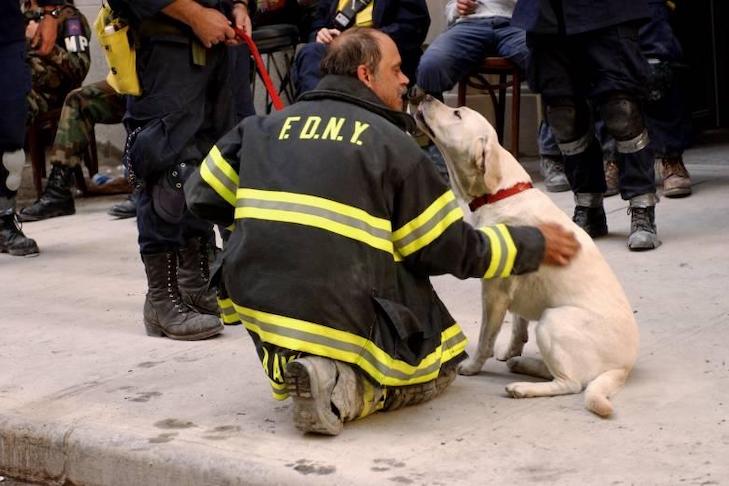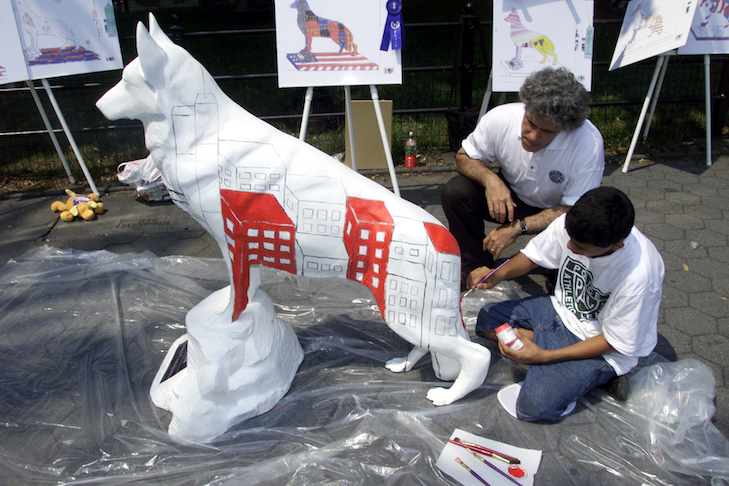
AKC is a participant in affiliate advertising programs designed to provide a means for sites to earn advertising fees by advertising and linking to akc.org. If you purchase a product through this article, we may receive a portion of the sale.

On Sept. 11, 2001, news reports of the nightmare unfolding in downtown Manhattan were relentless. Americans could not turn away; they were glued to their TVs and radios, listening to the carnage, terror, misery, and estimates of the loss of life that, as then-Mayor Giuliani said, would be “more than any of us can bear.”
Professionals — doctors, nurses, police officers, firefighters, and disaster-relief teams — dropped whatever they were doing and rushed from all over the country to New York. But for the average citizen, there was not much to do, except listen, wait, and hope.
One day after the attack, Dennis B. Sprung, the then-vice president of corporate relations for the American Kennel Club, heard something on CBS Radio about the 9/11 dogs that jolted him to action. “It was a plea to the public, that what was needed at Ground Zero was a portable X-ray machine for the dogs,” he recalls. “I said, ‘We can do that.’”
Helping 9/11 Dogs in Need
It was evening and Sprung arrived home, where there was a meeting of the Ladies Kennel Association of America. He interrupted the meeting and asked if someone could send an e-mail to anyone and everyone in the dog fancying world, asking for assistance in finding the equipment for the search-and-rescue (SAR) dogs at Ground Zero.

One woman volunteered, saying she could get the message out in the morning. “I said that I wanted them to call me that night, at home,” he says “I believed we could do it, so why wait?” The message went out within the hour. People started calling right away and continued through the night. “Dog people I knew. Dog people I did not know. People who knew dog people,” Sprung says.
By morning, they had located a medical equipment salesman in West Virginia who had a machine and many cartons of films, aprons, and gloves. Sprung would have to figure out a way to get the equipment to Manhattan. Another online request went out, and dog people stepped up again to relay it to the city, where, with a six-car police escort, Sprung got it to Ground Zero.
As soon as they arrived, a team of veterinarians unloaded and assembled the machine. Then the same six police cars whisked Sprung from the site. There was no time for a thank-you. That would come later. Right now, there were injured dogs that needed help. There was not a moment to waste.
“Through all of this, my mind was racing. What to do? What to do?” he says. “I thought this was the first step. What can we do to keep helping?”
Supporting Human and Canine Teams
Many of the estimated 300 9/11 dog-handler teams who came to New York were volunteers, working with their own money and on their own time. “They just got in their cars and came,” Sprung says. “I started thinking, How can we do something to thank them? And give them support so they can continue? The reality is, if it happens again, they may not be able to come back.”
In the days after 9/11, Sprung met with Poodle fancier Karen LeFrak. They discussed the idea of honoring SAR teams through an AKC program that would raise public awareness and appreciation of what these dogs and their handlers contribute.

The result was “DOGNY: America’s Tribute to Search and Rescue Dogs,” a fundraising and public art project supported by the AKC and its affiliate organization, AKC Companion Animal Recovery (CAR), now AKC Reunite. In connection with the program, the AKC established the AKC CAR Canine Support and Relief Fund as a permanent 501 (c) (3) charity to continue to provide support, funding, and other assistance to canine SAR organizations and animals affected by natural or civil disasters.
Sprung’s vision was a public arts initiative, similar to the CowParade a year earlier, that would involve the entire dog community. “That [the CowParade] was a private enterprise. I saw the concept evolving into a not-for-profit charity,” he says.
Sprung hired Daphna Straus, a communications specialist, to put together a business plan, and they presented it to the AKC Board of Directors, who gave unanimous support. The effort was co-chaired by Sprung, LeFrak, and AKC Chairman Ronald Menaker. Honorary co-chairs included Governor George Pataki, Mayor Michael Bloomberg, former Mayor Rudolph Giuliani, New York Police Commissioner Raymond Kelly, and New York Fire Commissioner Nicholas Scoppetta. Straus was the director of project development for DOGNY.
A Strong Symbol for DOGNY
The project’s symbol would be a German Shepherd Dog sculpted by artist Robert Braun and cast at the Meisner Gallery. The breed was selected because it is one of the most widely used in canine SAR.
“We brought the original clay model to the AKC, and displayed it during an open house,” says Sprung. “We brought in representatives from the German Shepherd Dog world, like Dr. Carmen Battaglia, to work with the sculptor, to make sure that the dog would be a good representative of the breed.”

AKC put out an open call for artists, which brought more than 300 designs. In fact, 111 DOGNY sculptures were produced for the tribute, and each was sponsored by a patron and painted by a commissioned artist, then displayed throughout the five boroughs of New York from August to November 2002.
A host of celebrities donated their time and funds. Supermodel Heidi Klum decorated a sculpture called “Dog with Butterflies,” and famed designer Vera Wang created a white, sequin-covered sculpture titled “Angel.” Cast members from the Broadway hit “Mamma Mia” unveiled two sculptures, “Broadway Loves DOGNY” and “Show Stoppers,” at Shubert Alley.
The Iams Company sponsored more than 20 sculptures, and Federal Express volunteered to handle the considerable transportation requirements, getting the statues back and forth from the artists’ studios and then to sites around town.
DOGNY: A Home Run
On Aug. 24, 2002, Yankee stars Jason Giambi, Derek Jeter, Roger Clemens, Alfonso Soriano, and their teammates shared the field at legendary Yankee Stadium with the AKC to honor DOGNY. Before a crowd of over 53,000, the AKC, the NYPD K-9 Unit, and several DOGNY sponsors received a standing ovation at a pregame ceremony at home plate.
Following the game, the Yankees unveiled their DOGNY statue, complete with a Yankee cap and pinstriped uniform, autographed by the team. A specially designed, limited-edition Yankees dog toy created by a major sponsor, the Hartz Mountain Corporation, was distributed to the first 25,000 children age 14 and younger who attended the game.
Prior to the game, Hartz had already established the Hartz/DOGNY “Help a Hero” toy program, a line of five unique, limited-edition plush dog toys, including GSD Scout and Bloodhound Ranger. For each toy sold, Hartz donated one dollar to the AKC/CAR Canine Support and Relief Fund. In appreciation for their enormous generosity, the AKC presented Hartz with a solid bronze DOGNY statue on October 2, 2003. Hartz’s remarkable contributions to the program totaled well over one million dollars.

A number of DOGNY sculptors were auctioned by Sotheby’s in November 2002 with proceeds of over $170,000. Famed columnist Liz Smith was the celebrity auctioneer. Soon after the Sotheby’s auction, Mayor Bloomberg declared “DOGNY DAY” in the city of New York — Dec. 16, 2002.
Since then, there have been three additional art auctions to benefit DOGNY, including the 2004 Doyle Gallery and 2005 “Dogs in Art” sales. In February 2006, Bonham’s charity brunch and private pre-auction viewing of the gallery’s extraordinary collection of dog art took place. In 2003, “The Canine Chronicle” and “Showsight Magazine” hosted benefit galas in support of DOGNY. The “Showsight” “Have a Heart Ball” gala continues as an annual event.
Clubs Pitch In
DOGNY owes much of its success to dedicated dog clubs and fanciers throughout the country. “People were wonderful, across the board,” says Sprung. Major corporations, from a host of pet product manufacturers to airlines to jeweler Tiffany & Co., threw their support behind the effort.
Hundreds of individual contributors came from all walks of life, from wealthy patrons who donated thousands, to dog owners who put $50 checks in the mail, “in honor of Snowball,” or other fondly remembered pets. “The fancy supported us on numerous levels,” Sprung notes. More than 100 clubs signed on as sponsors or contributors to DOGNY.
The Springfield (Massachusetts) Kennel Club started the ball rolling by being the first to sponsor a sculpture, “Galaxy Dog,” which was painted by DOGNY dog sculpture Robert Braun. The club continued its support of DOGNY by sponsoring a real police dog, Hammer, for the Springfield Police Department’s K-9 unit, and by organizing educational programs throughout the state.
Other groups jumped in. AKC member clubs from the Atlanta area, for example, donated a solid bronze DOGNY sculpture to the state of Georgia. Members of the 31 clubs and Governor Sonny Perdue unveiled the statue on the steps of the Capitol building in Atlanta on September 11, 2003.
Keeping DOGNY Going
Continuing the tribute to SAR teams around the country, the AKC instituted the DOGNY Heroic Military Working Dog Award in 2004. This award is presented annually to military dogs and handlers who distinguish themselves in active duty. A certificate and medal of honor are presented to a new team every year in a ceremony aboard the Intrepid Sea-Air-Space Museum.
The first DOGNY Heroic Military Working Dog Award was presented in 2004 by Chairman Menaker to GSD Frenke and handler Sergeant Herman Haynes. The team earned the distinction serving in Afghanistan and Iraq. At this ceremony, the AKC also presented a bronze DOGNY statue for permanent installation at “The Intrepid Remembers 9/11” exhibition.
In 2005, the award was presented to Specialist Jacob S. Nelson and his GSD, Ranny, who were deployed to Kuwait and Afghanistan.
Sprung notes Sept. 11 changed America. “I think the public’s respect of what dogs do to help our society has grown,” he says. “It’s becoming routine around our country for the public to see dogs on a daily basis performing tasks that help all of us. And any way that dogs are seen in a positive light is good for all dogs.”

The AKC has continued its ongoing commitment to educating the public about the vital work of canine SAR organizations. In 2006, the DOGNY program was included in two books. The first, “The Big American Art Book,” a 200-page, hardcover coffee-table book, features some of the best and most diverse public art projects in America. The second, “Dog Heroes of September 11th,” is a tribute to the working dogs of America.
Through April 2007, DOGNY was featured in London’s Imperial War Museum, during a special exhibition titled “The Animals’ War.” Two DOGNY statues, “Shower of Affection” and “Our Melting Pot,” were shipped overseas to the museum and were on loan for public viewing during the exhibition.
A book, “DOGNY: America’s Tribute to Search and Rescue Dogs,” shows all the painted statues and offers thumbnail sketches of the artists.
The AKC Gazette is the official journal of the sport of purebred dogs, and hasn’t missed an issue since 1889. Read the current AKC Gazette issue, sign up to receive new issues via e-mail, and browse 10 years of back issues on AKC.org.

